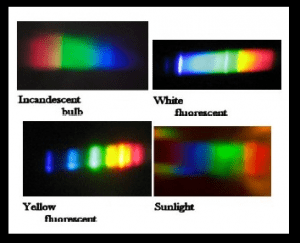Easy to Build, Fun to Use and Learn About Spectroscope Working Model

Learning about atoms in school seemed a bit dry. After all, they’re too small to see inside; too abstract and cerebral. But when I made this simple spectroscope design worked out by Ilan Shimony, a science/ gifted teacher in Israel, I could see the beginning of the hunt with my own eyes. Even just seeing the different “signature” of an incandescent vs.a fluorescent light spectrum got me quite interested. I learned a lot. Making an intuitive, exciting connection is a big part of what turns kids on or off. To science.
Note the following about Ilan Shimony’s spectroscope plans:
- The main plan is here, but:
- For North American users who use 8 ½ by 11 printer paper, use this pattern instead. You still need the directions from the other PDF.
- There is a different pattern depending on whether you use a CD or DVD, because of the angles.
- When you print, in the print dialogue box, select no scaling. Do not "fit to page".
- Ilan has some great explanations after the how-to part.
I had a wonderful time drifting from one Wikipedia article to another; from Joseph von Fraunhofer inventing the spectroscope and discovering dark spectrum lines to Neils Bohr when atoms revealed secrets at an accelerated pace. The scientific discoveries are intermingled with human triumphs and tragedies, travels, wars and serendipitous accidents. Mysteries can take centuries to solve, so I don't feel so bad that it's difficult that atomic theory is difficult to understand.. Science can be messy, with theoretical models having to be abandoned or modified as people have to grapple with new discoveries. The greatest of scientists still stand on the shoulders of their predecessors.
Troubleshooting
- “Task board” is sometimes called “poster board” where I live. It is thin cardboard.
- In steps 5 and 7, it might be a good idea to bore the holes to the full size of those printed on the pattern, so the spectrum is bright and easy to see. The first time I looked into my spectroscope, I couldn’t really see well. For the same reason, you might want to make the slit gap in step 6 the larger of the ranges that Ilan gives. Later, you can make make openings smaller to get better definition—all interesting learning. And also for the same reason, when looking at a fluorescent light or whatever, the slit end has to be pointing exactly toward the light source.
In my PDF viewer, the last line of step 6 is covered by the picture. Just look at the picture to see how to orient the slit.
If people send me tips of cool things they've done with spectroscopes, I'll make a new spectroscope feedback page.
